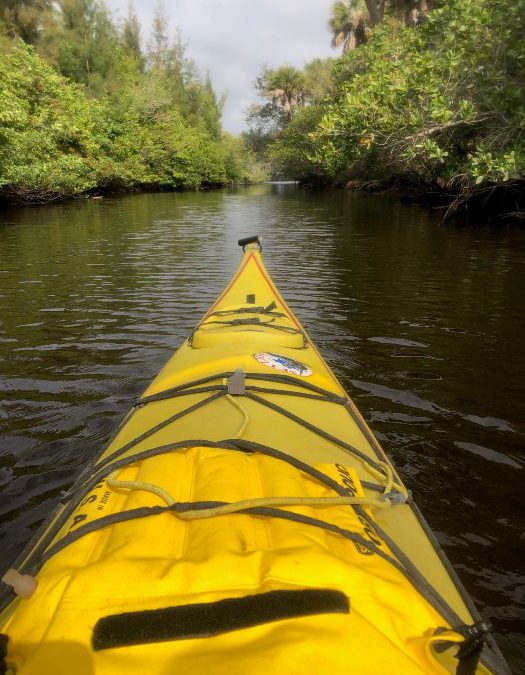
by Pat Williams | Oct 16, 2020
Pat is the County Extension Director and the Agriculture/Horticulture/Natural Resources agent for UF/IFAS Extension Wakulla County while also serving as the Master Gardener Volunteer Coordinator for both Franklin and Wakulla counties.
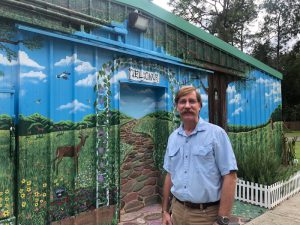
Pat by their outdoor mural at the Extension office.
He earned his doctorate from Texas A&M University in horticulture, a M.S. degree from Kansas State University in horticultural therapy, a B.S. degree in ornamental horticulture/floriculture from Cal Poly San Luis Obispo and an A.S. degree in ornamental horticulture from Crafton Hills College.
Over his horticulture career that started at age 13 working for Chrysanthemum Gardens in Crestline, CA, he has resided in 10 different states with a wide range of environmental influences (CA, KS, NJ, ME, NY, WA, TX, KY, TN and FL). He has held various positions in his career from teaching adults with developmental disabilities in NJ and ME, designing, installing and maintaining landscapes, landscape construction, being a horticultural therapist in New York City, working for the USDA in WA, teaching in a TX federal prison for his Extension appointment, teaching horticulture in a TN high school and was an university horticulture professor for 14 years in KY after teaching at Kansas State University, Washington State University and Texas A&M University as a teaching assistant. He started with the University of Florida/Institute of Food and Agricultural Sciences in April 2017 as the Sarasota County Residential Horticulture Agent/Master Gardener Volunteer Coordinator and transitioned to the Wakulla County Extension office in June 2020.
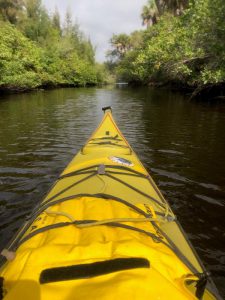
Kayaking the Myakka River, FL.
Teaching and greenhouse growing are his professional joys. Florida is the first state where there has not been a greenhouse to play in and he misses it greatly, however Extension does offer many opportunities to share his passion for plants and outdoors with a new group of learners. Otherwise Pat grew up on the beaches and ski resort areas of southern CA and still finds solace today relaxing on the beach or kayaking. He has traveled a bit visiting 49 states with only Hawaii to go. When indoors he would rather be baking or cooking in the kitchen as his second career choice would have been a chef. There is usually a yard full of flowers, herbs and vegetables and he is an extremely proud FSU Seminole Dad to Tara, a 2020 graduate.
Pat wears many hats at the Wakulla office and handles topics other than 4-H Youth Development or Family and Consumer Sciences. Once again he finds himself in a transition adapting to the new horticultural environment of Florida’s panhandle and developing more programs in agriculture and natural resources. Please feel free to reach out to see how the UF/IFAS Extension Wakulla County can be of assistance.
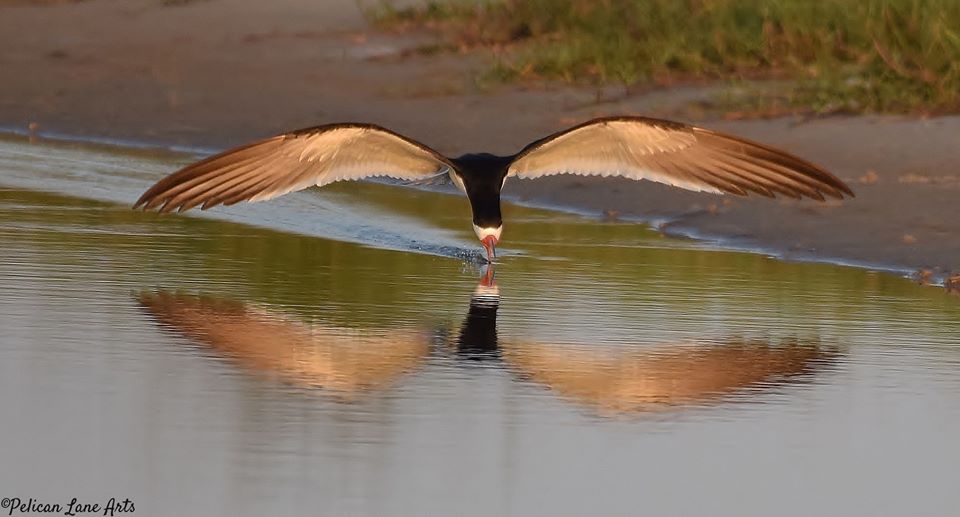
by Chris Verlinde | May 1, 2020
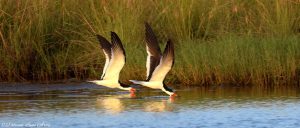
Black Skimmers foraging for fish. Photo Credit: Jan Trzepacz, Pelican Lane Arts.
Black Skimmers and Least Terns, state listed species of seabirds, have returned along the coastal areas of the northern Gulf of Mexico! These colorful, dynamic birds are fun to watch, which can be done without disturbing the them.
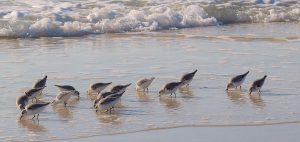
Shorebirds foraging. Photo Credit: Jan Trzepacz, Pelican Lane Arts.
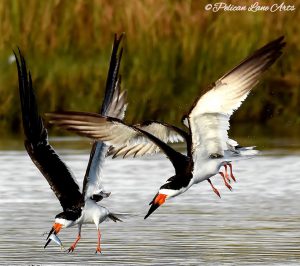
Black Skimmer with a fish. Photo Credit: Jan Trzepacz, Pelican Lane Arts.
What is the difference between a seabird and shorebird?
Among other behaviors, their foraging habits are the easiest way to distinguish between the two. The seabirds depend on the open water to forage on fish and small invertebrates. The shorebirds are the camouflaged birds that can found along the shore, using their specialized beaks to poke in the sandy areas to forage for invertebrates.
Both seabirds and shorebirds nest on our local beaches, spoil islands, and artificial habitats such as gravel rooftops. Many of these birds are listed as endangered or threatened species by state and federal agencies.
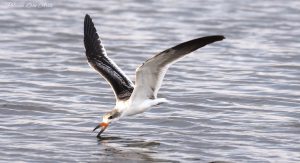
Juvenile Black Skimmer learning to forage. Photo Credit: Jan Trzepacz, Pelican Lane Arts.
Adult black skimmers are easily identified by their long, black and orange bills, black upper body and white underside. They are most active in the early morning and evening while feeding. You can watch them swoop and skim along the water at many locations along the Gulf Coast. Watch for their tell-tale skimming as they skim the surface of the water with their beaks open, foraging for small fish and invertebrates. The lower mandible (beak) is longer than the upper mandible, this adaptation allows these birds to be efficient at catching their prey.
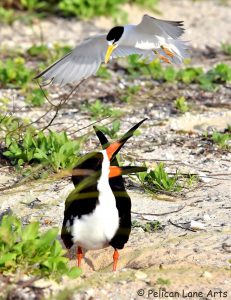
Least Tern “dive bombing” a Black Skimmer that is too close to the Least Tern nest. Photo Credit: Jan Trzepacz, Pelican Lane Arts.
Adult breeding least terns are much smaller birds with a white underside and a grey-upper body. Their bill is yellow, they have a white forehead and a black stripe across their eyes. Just above the tail feathers, there are two dark primary feathers that appear to look like a black tip at the back end of the bird. Terns feed by diving down to the water to grab their prey. They also use this “dive-bombing” technique to ward off predators, pets and humans from their nests, eggs and chicks.
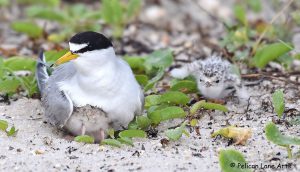
Least Tern with chicks. Photo Credit: Jan Trzepacz, Pelican Lane Arts.
Both Black Skimmers and Least Terns nest in colonies, which means they nest with many other birds. Black skimmers and Least Terns nest in sandy areas along the beach. They create a “scrape” in the sand. The birds lay their eggs in the shallow depression, the eggs blend into the beach sand and are very hard to see by humans and predators. In order to avoid disturbing the birds when they are sitting on their nests, known nesting areas are temporarily roped off by Audubon and/or Florida Fish and Wildlife Conservation Commission (FWC) representatives. This is done to protect the birds while they are nesting, caring for the babies and as the babies begin to learn to fly and forage for themselves.
Threats to these beautiful acrobats include loss of habitat, which means less space for the birds to rest, nest and forage. Disturbances from human caused activities such as:
- walking through nesting grounds
- allowing pets to run off-leash in nesting areas
- feral cats and other predators
- litter
- driving on the beach
- fireworks and other loud noises
Audubon and FWC rope-off nesting areas to protect the birds, their eggs and chicks. These nesting areas have signage asking visitors to stay out of nesting zones, so the chicks have a better chance of surviving. When a bird is disturbed off their nest, there is increased vulnerability to predators, heat and the parents may not return to the nest.
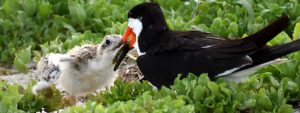
Black Skimmer feeding a chick. Photo Credit: Jan Trzepacz, Pelican Lane Arts.
To observe these birds, stay a safe distance away, zoom in with a telescope, phone, camera or binoculars, you may see a fluffy little chick! Let’s all work to give the birds some space.
Special thanks to Jan Trzepacz of Pelican Lane Arts for the use of these beautiful photos.
To learn about the Audubon Shorebird program on Navarre Beach, FL check out the Relax on Navarre Beach Facebook webinar presentation by Caroline Stahala, Audubon Western Florida Panhandle Shorebird Program Coordinator:
In some areas these birds nest close to the road. These areas have temporarily reduced speed limits, please drive the speed limit to avoid hitting a chick. If you are interested in receiving a “chick magnet” for your car, 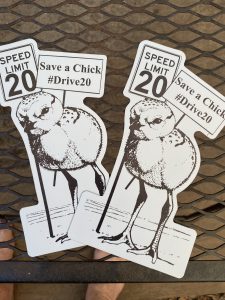 to show you support bird conservation, please send an email to: chrismv@ufl.edu, Please put “chick magnet” in the subject line. Please allow 2 weeks to receive your magnet in the mail. Limited quantities available.
to show you support bird conservation, please send an email to: chrismv@ufl.edu, Please put “chick magnet” in the subject line. Please allow 2 weeks to receive your magnet in the mail. Limited quantities available.
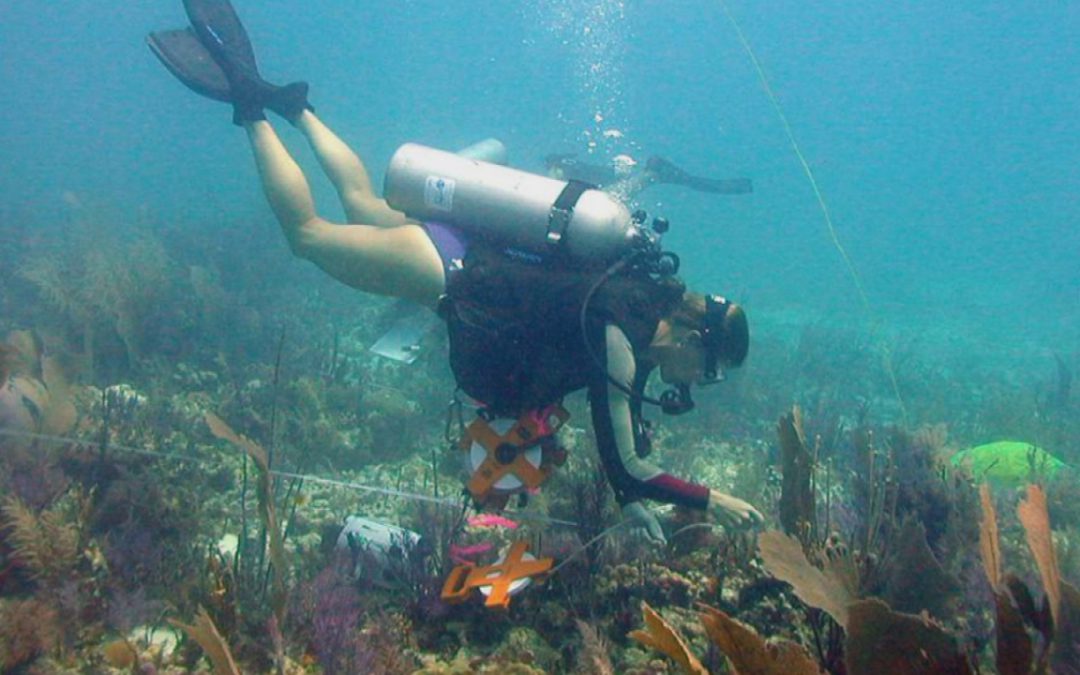
by Rick O'Connor | Aug 27, 2019
We like to post articles about fun and adventurous activities people can do outdoors in the Florida panhandle… but it is very hot out there this time of year. What sort of outdoor adventure can you have when the temperatures are running in the 90s and the humidity in the 80% range?
Water…
Many of us have our favorite swimming holes – local rivers, springs, estuaries, or the Gulf itself, but what about SCUBA? I recently talked to a local dive charter and they said the current weather pattern is not a problem for them. The seas are relatively calm – easy to get offshore, you are underwater – so not so hot, and afternoon rains washes the gear off. Sounds like a good adventure on a hot summer day.
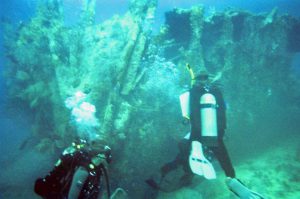
Diving near large coral.
Photo: Indiana University
But SCUBA is not for everyone. My wife tried and did not care for it. It certainly makes some folks nervous. Underwater seems confining to many. There is a lot of equipment you have to wear, and that can be bothersome. There are creatures out there, some of them rather large. And then there is the risk, many see SCUBA as a dangerous activity – and it can be. This is why they require a course for certification… to address all of these issues.
During the course they will put you in a swimming pool with the gear and see how comfortable you are. Honestly, I remember the first time I tried the tank. My brain was telling me “DO NOT INHALE… YOU ARE NOT A FISH”. But eventually I did, and MAN was that cool. As you become more comfortable you can swim some. All of this is done at the shallow end so if it is not working for you – you are fine. The equipment really is not that cumbersome while in the water. Swimming slow laps, getting use the breathing on the equipment, clearing your mask if water gets in, they teach you everything you need to know to be relaxed while underwater.
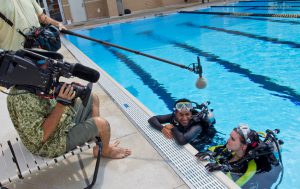
Student and instructor practice SCUBA skills in a swimming pool.
Photo: University of Central Florida.
There are skills you will need to learn while in the pool, and then the there is the classroom sessions. Much of it deals with the danger issue of diving – what could go wrong. As Jacques Cousteau once said, it is not going down that is the problem, it is coming back. We are all aware of the pressure changes that occur as you descend into the ocean. There is air pressure on your body at sea level – about 15 p.s.i. We do not notice this because our body compensates for it. However, as you descend into the water the pressure increases 15 p.s.i. every 33 feet you descend. You will feel this and are taught how to compensate for it. Once on the bottom, you will find all sorts of structures, fish, sometimes even sea turtles. You swim around trying to take it all in, but the entire you are down the pressure is pushing gases into your body. When it is time to return, you must do this the correct way – “gas off” as they say. Again, local instructors will explain all of this in class and you will have a chance to practice in the pool.
Then there is the open water dive.
You get a chance to test your skills in the open Gulf.
Again, this makes some a bit nervous. It is one thing in the safety of a swimming pool. It is another in the wild blue. There are jellyfish, fish, bigger fish, waves, can’t see the bottom yet, pirates, who knows what is running through your mind. But you are with friends. Everyone is going through the same experience and you have master divers at your side. It is all good. You eventually reach the bottom and see a world that is truly amazing.
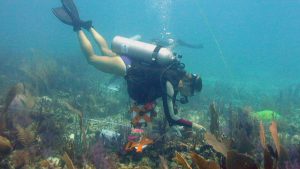
A diver explores a coral reef.
Photo: NOAA
Again, SCUBA is not for everyone, but it is a fun activity on these hot summer days. Something to consider trying. There are many great dive instructors along the Florida panhandle, and one near you. If SCUBA is too much – consider snorkeling, it can be a rewarding activity as well.
Stay cool.
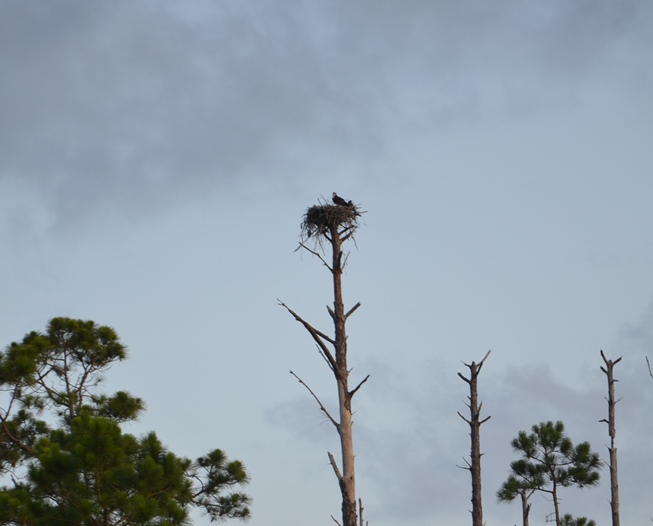
by Rick O'Connor | Aug 17, 2018
As a kid growing up here along the Gulf Coast, I had never heard of an osprey. Now, there is at least one mating pair on almost every body of water in the Pensacola Bay area. Where did this once unknown bird come from? How has it successfully colonized our coastal waterways?
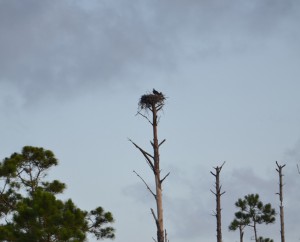
Osprey nesting sites are commonly near water, and their food source.
The osprey, like many other fish eating birds, was a victim of the DDT story. This miracle pesticide was developed to battle insects attacking food crops but was found to be useful against mosquitos and many other unwanted pests. It was sprayed everywhere using planes, trucks, and tractors. With an extremely long half-life, wherever it landed it was going to be around for a while – it can still be found in the sediments of the Pensacola Bay System. It was one of those compounds that was difficult to excrete through an organisms excretory system – thus it accumulated within their tissues, and as organisms fed on other organisms, it was passed up the food chain – bioaccumulation. Birds of prey who fed on fish would accumulate DDT as well. It caused the shells of their eggs to become thinner – so nesting was not successful – and many of the aquatic birds of prey (pelicans and eagles alike) declined in number. DDT was banned in 1970s and many of these fish eating birds have made a remarkable recovery – a true success story.
So who is this fish eating bird of prey that can be found on dead trees and light posts all over the bay area?
Ospreys (Pandion haliaetus) are members of the family Accipitridae – the hawks and eagles.
They are predators with hooked bills and sharp talons to grab and dispose of prey. Ospreys can be identified by the hawk like silhouette hovering over a local waterway searching for fish – their primary food. They are usually in pairs and, at times, the young are hovering nearby. Their call is a high pitch chirping sound and if seen on a tree, or on their nest, they are brown on top and white beneath. These birds are common along both fresh and saltwater bodies of water.
Ospreys prefer waterways where fish are plentiful. For more successful hunting, they like waters that are relatively shallow and nesting locations that protect the young from mammalian predators. Many local osprey prefer large dead trees for their nests, and will often use manmade structures – such as power poles, navigation markers, and special platforms on poles placed there for the purpose of osprey nesting.
Osprey feed almost exclusively on fish. They are unique in the hawk world in that their talons can adjust so that the captured fish can be turned parallel to the osprey’s body – making it more aerodynamic when returning to the nest. Hunting osprey hover over the water searching and then dive, talons first into the water. They can only reach depths of about three feet so they typically hunt for surface schooling fish, or in shallow waters. Most of their captures are between 8-10 inches and include such fish as speckled trout, mullet, and catfish.
These birds are monogamous (mating pairs breed for life). During the breeding season, the male will collect sticks for the construction of their large nests. Bringing them back to the female, she will begin to arrange and construct the nest. The male provides seagrass and flotsam for the inner lining. There is a pre-courtship dance where the returning male flies over the nest with a fish. The pair produce between 3-4 eggs. Both parents will incubate the eggs but the female does the lions share. She will incubate while the male hunts. Returning with a fish for her, she will fly to a nearby branch to feed while he incubates the eggs – though they have seen the males incubate even without feeding the female. Evening incubation is always the female.
After hatching, the male will bring food to both the female and young. She does not leave the young at all for about 14 days. Afterwards, they will be left alone for periods of time, and are usually fledged by 50 days. Data shows that young fledglings rarely disperse more than 30 miles from the nest they hatched from – suggesting slow dispersal of this species. The mating pair will return to the same location for nesting every year for up to 30 years.
There are few predators of osprey due to their nesting habits. In some locations, where they nest on the ground, coyotes have been a problem. Locally, bald eagles are known to try to grab hatchlings and, occasionally, adults. There have been reports of crocodiles taking adults from the water in South Africa; this may be the case in South America as well, but no reports of American Alligators doing the same.
This is now a common bird along our shores and is a true conservation success story.
References
National Audubon Society Field Guide to North American Birds; Eastern Region. Ed. J. Bull, J. Farrand Jr. pp. 795.
Osprey. Neotropical Birds. Cornell Lab of Ornithology. https://neotropical.birds.cornell.edu/Species-Account/nb/species/osprey/overview.
by Laura Tiu | Apr 14, 2018
Spring has sprung and it is time to get outside and explore this great Florida Panhandle area. In neighboring Santa Rosa County, a terrific destination for a variety of outdoor activities is Blackwater River State Park. Visitors can canoe, kayak, tube, fish and swim the river. Hikers can enjoy trails through nearly 600 acres of undisturbed natural communities. Bring a picnic and hang out at one of several pavilions or white sand beaches that dot the river (restroom facilities available). Near the pavilions, stop and see one of the largest and oldest Atlantic white cedars, recognized as a Florida Champion tree in 1982. The park also offers 30 campsites for tents and RVs. Park entry is $4.00 per car, payable at the ranger station or via the honor system (bring exact change, please).
The Blackwater River is considered one of the purest and pristine sand-bottom rivers in the world. The water is tea-colored from the tannins and organic matter that color the water as it weaves through the predominantly pine forest. The river is shallow with a beautiful white sandy bottom, a nice feature for those tubing or paddling the trail. The river flows for over 50 miles and is designated as a Florida canoe trail. Multiple small sand beach areas line the river and provide plenty of space to hang out, picnic, or throw a Frisbee. Blackwater eventually flows into Pensacola Bay and the Gulf of Mexico bringing high quality freshwater into this important estuary.
A favorite trail in the Park is the Chain of Lakes Nature Trail. Parking for this 1.75 mile loop trail is at South Bridge on Deaton Bridge Road. The trail head is well marked and has a boardwalk that leads into the floodplain forest. The trail winds through a chain of shallow oxbow lakes and swamp that dot the former route of the river. If you are lucky and it is a clear, blue-sky day, you may see a beautiful rainbow effect as the sun hits the water. We call this the pastel swamp rainbow effect. This is a result of the natural oils from the cypress cones settling on the surface of the water and associated trapped pollen.
The trail then turns to sneak through the sandhill community in the park with giant longleaf pines, wiregrass and turkey oak. Evidence of prescribed burning shows management efforts to maintain the forest. Cinnamon ferns, bamboo and other natives appear in pockets along the trail. The trail in this section is blanketed with a mosaic of exposed root systems, so be careful as you step. Finally, pack some bug spray and a water bottle for this fun hike.
For more information, visit the park page: https://www.floridastateparks.org/park/Blackwater-River
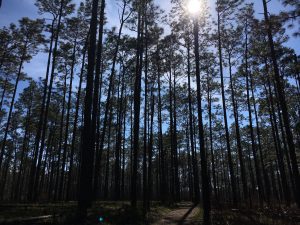
Sandhill pine forest at Blackwater River State Park
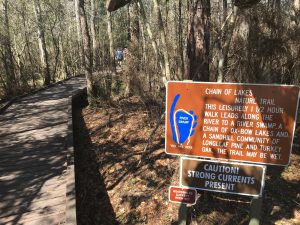
2737 – Chain of Lakes trailhead at Blackwater River State Park

“Rainbow Swamp” on the Chain of Lakes trail at Blackwater River State Park

Beautiful sandy beaches along the Blackwater River in the State Park.






















